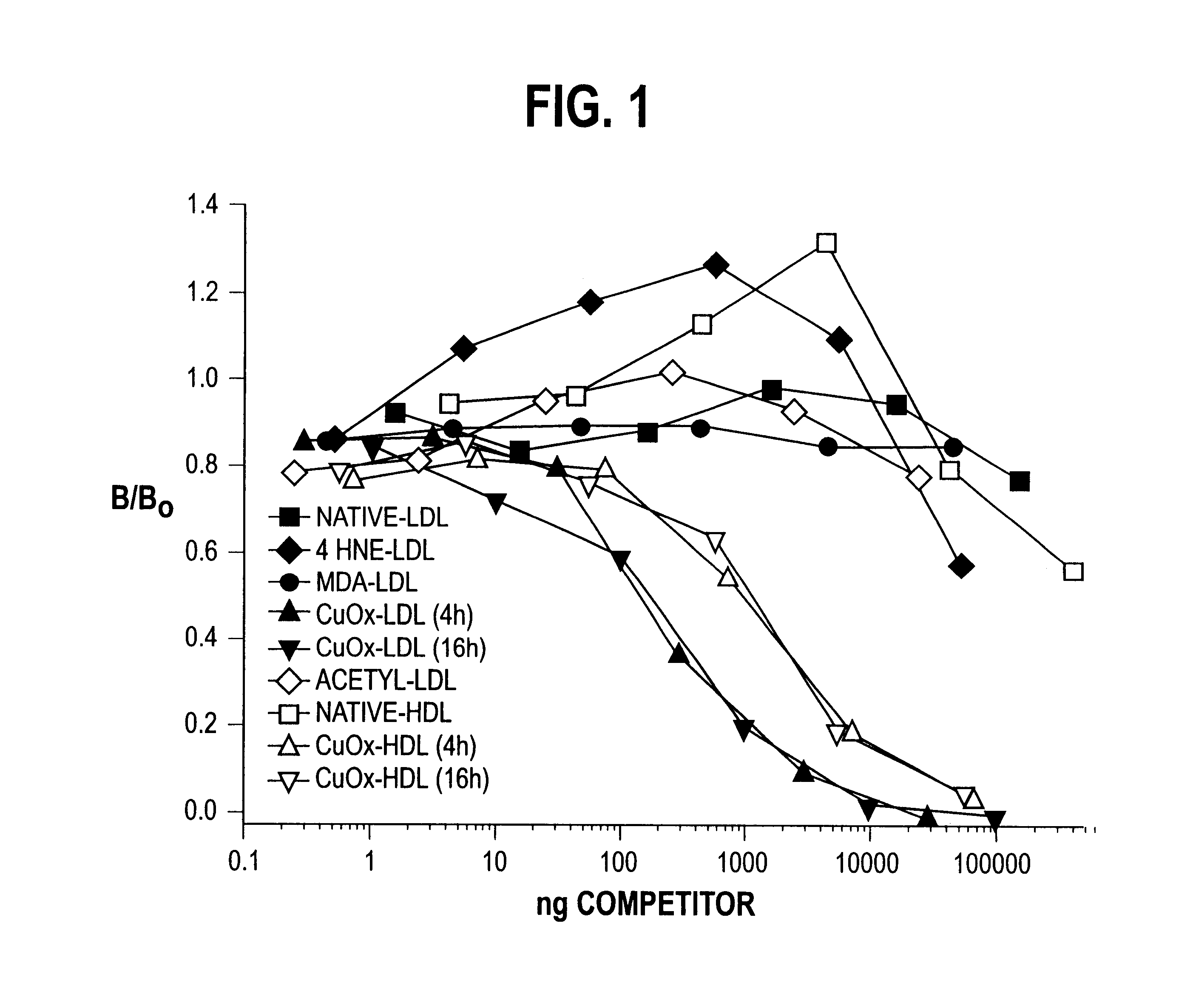Antibodies to oxidation-specific epitopes on lipoprotein and methods for their use in detecting, monitoring and inhibiting the growth of atheroma
a technology of lipoprotein and anti-oxidation specificity, which is applied in the field of anti-oxidation-specific epitopes on lipoprotein and methods for their use in detecting, monitoring and inhibiting the growth of atheroma, can solve the problems of inconvenient use and lack of specificity of agents
- Summary
- Abstract
- Description
- Claims
- Application Information
AI Technical Summary
Benefits of technology
Problems solved by technology
Method used
Image
Examples
example ii
Preparation of Artifactual Oxidation Protected Oxidazed Lipoprotein Antigens
Human LDL and HDL were freshly isolated from plasma of healthy human donors by sequential ultracentrifugation in the presence of high concentrations of antioxidants. Native LDL was stored at 4.degree. C. and used within 2wk. LDL and other proteins were modified with MDA and 4-HNE using known techniques. The degree of modification of the lysine residues of apo B was determined by trinitrobenzenesulfonic acid assay. The extent of modification was also verified by comparing the electrophoretic mobility of the modified lipoproteins to that of native LDL, using 1% agarose gels (Corning Medical and Scientific, Palo Alto, Calif.) in borate buffer, pH 8.6. For the initial screening of hybridomas, extensively modified MDA-LDL was used (.about.75% of the lysine residues modified), whereas MDA-LDL preparations with varying degrees of modification were generated for the subsequent characterization assays.
Cu2+-LDL was ge...
example iii
Determination of E0 Antibody Titers and Specificity
Initial screening of plasma, hybridoma supernatants, ascites, and purified antibodies was performed with conventional solid-phase RIA techniques. For binding assays, 96-well polyvinylchloride microtitration plates (Dynatech Laboratories, Inc., Chantilly, Va.) were coated with of antigen (5 g / ml) in PBS containing 0.27 mM EDTA and 20M butylated hydroxytoluene overnight at 4.degree. C. Non-adherent antigen was aspirated and remaining binding sites were "blocked" by incubation with 2% BSA (RIA grade, Sigma Chemical Co., St. Louis, Mo.) in PBS for 45 min at room temperature. The wells were washed four times with PBS containing 0.27 mM EDTA, 0.02% NaN.sup.3, 0.05% Tween 20, and 0.001% aprotinin (washing buffer), using a microtiter plate washer. Serial dilutions of antibody in washing buffer containing 3% BSA (dilution buffer) were prepared, added at 50 .mu.l / well, and incubated overnight at 4.degree. C.
The amount of immunoglobulin bound ...
example iv
Detection of Epitopes of Oxldl on Circulating LDL by E0 Antibodies
To determine if any of the E0 series of antibodies would recognize epitopes on circulating LDL, a sensitive, double-layered sandwich chemiluminescent immunoassay was developed. In this assay, goat anti-mouse IgG-Fc-specific antiserum (GAM-IgG) was coated on microtiter wells to which monoclonal antibody MB47, which binds to apo B with high affinity, was then added as the bottom layers of the sandwich. (The GAM-IgG Fc binds MB47 so as to maximize the expression of its two binding sites.) A 1:50 dilution of plasma was then added to allow binding of LDL, the middle of the sandwich. After extensive washing, an appropriate dilution of one of the IgM antibodies against OxLDL (the E0 antibodies) was then added as the top of the sandwich, and this in turn was detected by an alkaline phosphatase-labeled goat anti-IgM antibody. Non specific murine IgM were used in place of E0 antibodies as a control.
As shown in FIG. 5, antibodie...
PUM
| Property | Measurement | Unit |
|---|---|---|
| pH | aaaaa | aaaaa |
| pH | aaaaa | aaaaa |
| temperature | aaaaa | aaaaa |
Abstract
Description
Claims
Application Information
 Login to View More
Login to View More - R&D
- Intellectual Property
- Life Sciences
- Materials
- Tech Scout
- Unparalleled Data Quality
- Higher Quality Content
- 60% Fewer Hallucinations
Browse by: Latest US Patents, China's latest patents, Technical Efficacy Thesaurus, Application Domain, Technology Topic, Popular Technical Reports.
© 2025 PatSnap. All rights reserved.Legal|Privacy policy|Modern Slavery Act Transparency Statement|Sitemap|About US| Contact US: help@patsnap.com



